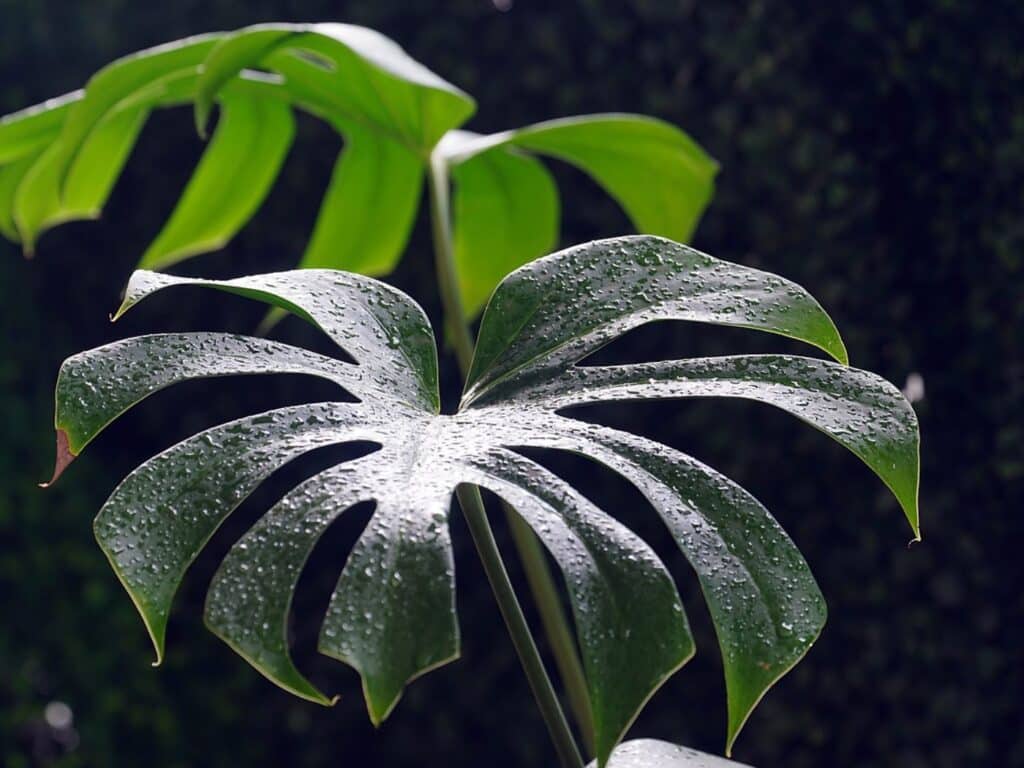Caring for your monstera plant can sometimes feel like a delicate dance, especially when it comes to watering. Overwatering is a common misstep that many plant enthusiasts face, leading to a host of issues that can leave your beloved green friend struggling for survival.
If you’ve noticed your monstera’s leaves turning yellow or its soil feeling perpetually soggy, you’re likely dealing with the consequences of too much water.
Understanding the fine line between hydration and overhydration is crucial for the health of your monstera. This article aims to guide you through identifying the signs of overwatering, understanding its effects on your plant, and most importantly, offering solutions to restore your monstera to its full, flourishing glory.
Let’s embark on this journey to ensure your monstera thrives, showcasing its majestic beauty in your space.
Recognizing the Signs of an Overwatered Monstera
Tending to your monstera’s needs accurately can be a bit tricky, especially with watering. Too much love in the form of water may well lead to trouble. Let’s dive into the signs that your monstera is pleading for a watering schedule intervention.
Yellowing Leaves
If you notice the leaves of your monstera turning yellow, it’s waving a big flag at you saying, “Help!” Overwatering causes the roots to drown and rot, preventing them from delivering the necessary nutrients to the plant.
As a consequence, the leaves start to show their distress through a color change. A leaf or two turning yellow could be a natural process, but if it’s a widespread phenomenon, your monstera’s shouting for a change.
Wilting and Soft Stems
Stems that are wilting or feel unusually soft to the touch are telltale signs of too much water. Healthy monsteras stand tall and proud, but overwatering weakens the stems, leaving them unable to support the weight of the plant. It’s as if the stems have given up, and without intervention, the entire plant may well soon throw in the towel.
Mold and Algae Growth
Finally, keep an eye out for unwanted guests: mold and algae. If you spot a furry or slimy green guest making itself at home on the soil, that’s your cue.
Excess moisture creates a perfect party spot for mold and algae, and trust me, that’s a party you want to shut down immediately. This not only looks unsightly but can also further harm the roots and health of your plant.
By recognizing these signs early, you can adjust your watering routine and help your monstera flourish. Remember, your monstera doesn’t need a pool—just a drink now and then.
The Science Behind Overwatering
How Overwatering Affects Root Health
When you give your monstera more water than it can absorb, you’re essentially drowning its roots. An overwatered monstera’s roots sit in moisture for too long, leading to a lack of oxygen. This oxygen deprivation prevents the roots from functioning properly, inhibiting their ability to absorb water and nutrients.
Think of it as trying to breathe with a heavy blanket over your head – not the most comfortable situation, right? Over time, this waterlogged environment fosters fungal growth, such as root rot, which further harms the plant’s health by destroying its root system.
So, if you find yourself reaching for the watering can too often, remember, you may well be doing more harm than good.
The Role of Oxygen in Plant Survival
Oxygen plays a crucial role in a monstera’s survival, much like it does for humans. Roots need oxygen to respire, which is how they convert glucose and oxygen into the energy needed for growth and nutrient absorption. Overwatering fills the spaces in the soil that would normally hold air with water instead, reducing oxygen availability.
This scenario makes it challenging for the plant to perform essential functions, leading to stressed, weakened roots that are more susceptible to diseases. So, ensuring your monstera’s soil has proper drainage and drying out between waterings isn’t just a good practice—it’s a lifeline for your leafy friend.
Immediate Steps to Save an Overwatered Monstera

Assessing the Damage
First things first, check how badly your monstera has been overwatered. Gently remove the plant from its pot and inspect the roots. Healthy roots look white and feel firm.
If they’re brown, mushy, or have a foul smell, root rot has set in. Yellowing leaves can also indicate trouble above the soil. Identifying these issues early can make all the difference in saving your plant.
Adjusting Your Watering Routine
Overenthusiasm with watering can drown your monstera’s roots. To prevent further harm, adjust your watering habits. Ensure the top inch of soil is dry before reaching for the watering can again.
This method gives your monstera the moisture it needs without overdoing it. Remember, your monstera doesn’t need a daily drink, so let the soil be your guide.
Improving Soil Drainage
Improving soil drainage is like giving your monstera a life raft. Mix perlite or orchid bark into the existing potting soil to increase aeration and drainage.
This tweak allows excess water to escape easily, preventing the dreaded waterlogged scenario. If you’ve been using a pot without drainage holes, switching to one that has them can also prevent overwatering mishaps.
Long-Term Care for a Monstera

Successfully caring for a monstera after it’s experienced overwatering incorporates steady adjustments in its environment and care routines. The goal is straightforward: foster healthy growth and prevent recurrence of the issue. Let’s dive into how you can achieve this with the right potting, watering schedule, and environment.
The Importance of Proper Potting
Choosing the right pot plays a crucial role in the health of your monstera. Opt for a pot with enough drainage holes to allow excess water to escape easily, preventing water from pooling at the bottom.
Combining this with a well-draining soil mix, such as a blend of peat, pine bark, and perlite, offers the roots the breath of fresh air they need to thrive. Remember, a happy monstera is one that doesn’t sit in soggy soil!
Creating an Ideal Watering Schedule
Finding the perfect balance in watering can sometimes feel like you’re walking a tightrope. Too much or too little water, and your monstera may well not forgive you. A general rule of thumb is to water your plant once the top inch of the soil feels dry to the touch.
This frequency will vary based on the time of the year, with the plant requiring more water during the growing season (spring and summer) and less during the dormant season (fall and winter). Consistency is key, so mark your calendar or set a reminder to check the soil moisture regularly.
Monitoring Humidity and Sunlight
Monsteras are tropical plants, meaning they love a good humidity level around them. Aim to keep the humidity around your plant between 60% to 80% to mimic its natural habitat.
You can achieve this by using a humidifier, placing a water tray near the plant, or grouping it with other houseplants to create a mini humid environment. As for sunlight, indirect bright light is the sweet spot.
Direct sunlight can be too harsh, leading to leaf burn, while too little light can slow down growth and leaf development. Find a spot that gets plenty of ambient light, and your monstera will show its appreciation through lush, green growth.
Preventative Measures to Avoid Overwatering
Choosing the Right Soil Mix
Selecting the right soil mix for your monstera is critical. Opt for a lightweight, airy soil that promotes proper drainage. A mix containing peat moss, perlite, and pine bark not only encourages healthy root growth but also prevents water from getting trapped around the roots, a common issue leading to overwatering woes.
Understanding Pot Size and Type
The size and type of pot play a pivotal role in your monstera’s health. Always choose a pot that’s appropriately sized for your plant; too large, and the soil will stay wet for longer, increasing the risk of root rot.
Ceramic or terracotta pots are preferable because they allow the soil to breathe and excess water to evaporate more efficiently than plastic pots.
Using Moisture Meters and Indicators
To take the guesswork out of watering your monstera, incorporate moisture meters or indicators into your care routine. These handy tools give you a clear idea of when it’s time to water, based on soil moisture levels. This method ensures you’re only watering your plant when necessary, effectively preventing overwatering.
Up next: Overwatered Arborvitae: Signs, Solutions, and Prevention Tips







